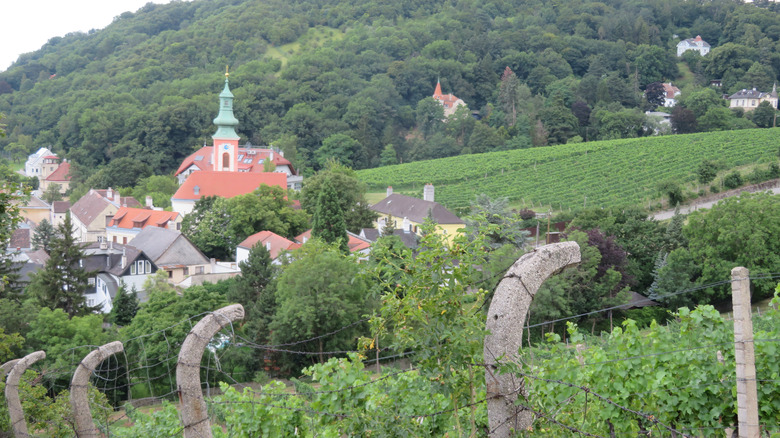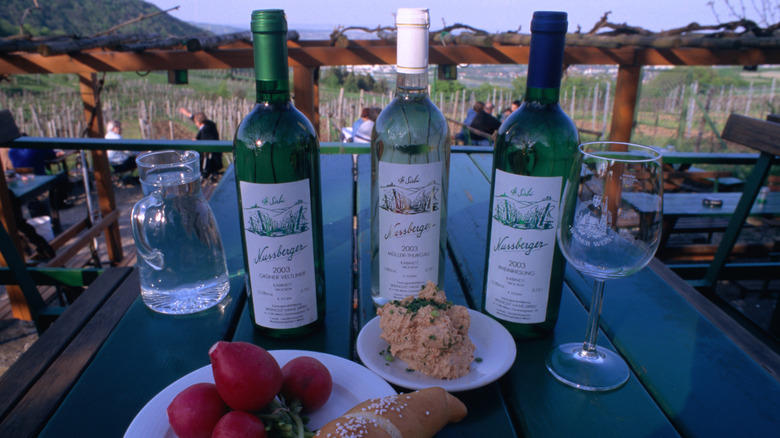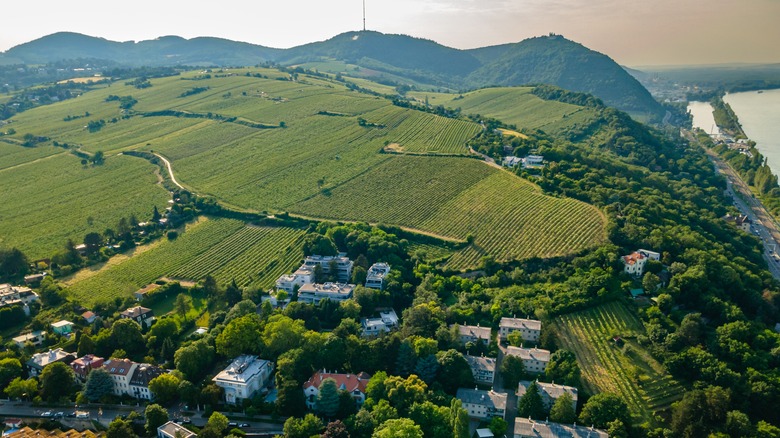Experience Vienna's Unforgettable Wine Culture In This Untouristed Area Rick Steves Suggests
Sipping wine in a Viennese wine garden or "heuriger" sounds like a dream. Imagine yourself relaxing at a table with some snacks and a lovely glass after a trip to a the nearby "Caribbean of the Alps" or a romantic river cruise down the Danube. Vienna proper, however, can be very busy with tourists who have the very same idea. Enter travel pro Rick Steves, who suggests one particular area in the city as less frequented by tourists. This spot is Nussdorf, which translates to "nut village and sits about 30 minutes by public transport outside of the city center in the 19th district. Most importantly, it has plenty of these wine gardens to visit.
Steves says of the area, "To avoid tour groups, try Nussdorf, popular with Viennese. Music lovers head to Heiligenstadt [its bordering village] to visit the Beethovenhaus wine garden, where the composer lived and began work on his Ninth Symphony." Plus, as Steves explains, "Compared to most modern urban centers, the pace of life here is slow. Locals linger over pastry and coffee at cafés. Concerts and classical music abound. And chatting with friends at a wine garden is not a special event but a way of life." In Nussdorf, you get to experience that slow pace for yourself.
The wine gardens of Nussdorf
Heuriger means "new wine," and these establishments' vintages come from recently harvested grapes from their own vineyards. They can be fairly tart, and you can order them in two ways: Ask for a "viertel," which is a quarter of a liter or around 8.5 fluid ounces and comes in a mug glass that you might expect to see beer in, or order an "achtel," which is half of that and comes in a wine glass. Generally, a viertel runs between $2.75 and $3.25.
You'll find some heurigen (the plural form of "heuriger") with outdoor seating and they have the ambience of a tavern. If you want to visit more than one, there is a map of many of them on a wall at the beginning of Kahlenberger Strasse (or street) in Nussdorf. You won't be alone. Helena Hartlauer of the Vienna Tourist Board told the BBC, "Currently around 70% of Vienna's annual wine yield is drunk at the capital's Heurigen." This all came about in 1784 when Emperor Joseph II ruled that people could sell self-made wine without a license, but only for a certain number of days, and only with cold food.
These days, they operate on a normal schedule and serve hot food as well. If you see one with a pine bough on the door, that traditionally means there is new wine available. Generally you order the food at a counter and take it back to your own table to enjoy.
A Beethoven heuriger and a fall wine to try
The spot that Steves recommends trying is the heuriger where Beethoven once lived, Heuriger Mayer am Pfarrplatz, which sits on the border of the villages of Nussdorf and Heiligenstadt. (Pfarrplatz is the name of the street he lived on.) This place has been making wine since 1683 and Beethoven himself lived here in 1817 while working on his masterpiece, Symphony No. 9. There is a sun terrace, Viennese music, and food items like asparagus cordon bleu, or beef onion roast, as well as Austrian cheeses. There is even a playground for the kids next door.
If you end up heading back in the Vienna city center and you happen to be visiting in July and August, Steves says it's worth checking out the free concerts that are often broadcast on a large screen in the park in front of Rathausplatz, or city hall, with food stands and picnic tables. Just leave your shorts at home, as they're not really worn in Austria. If you're in Nussdorf (or anywhere else in Vienna) in the fall instead, he says to try Sturm, which is, " ... semi-fermented new wine made from the season's first grape harvest and only available in autumn. Many locals claim that it takes several years of practice to distinguish between Sturm and vinegar. The red version is so hearty and fruity that locals say 'Eat up!' when toasting with it." It's certainly worth a try.


